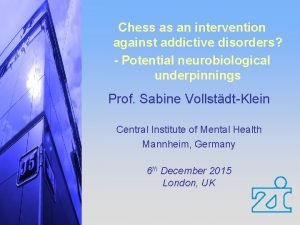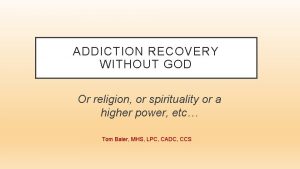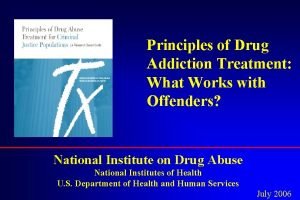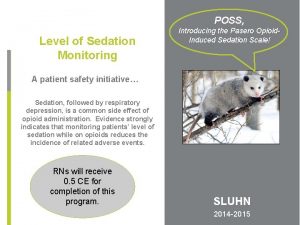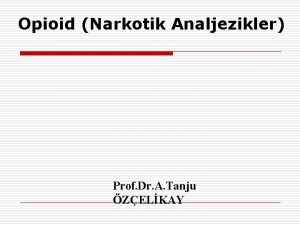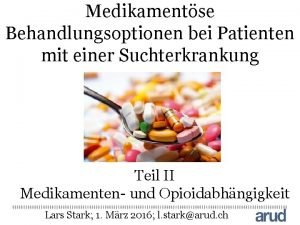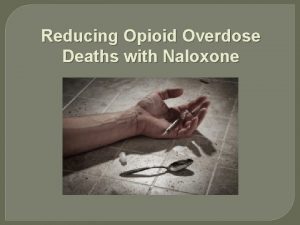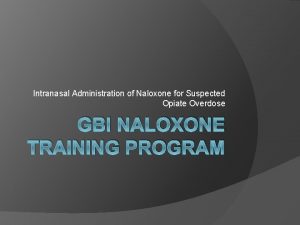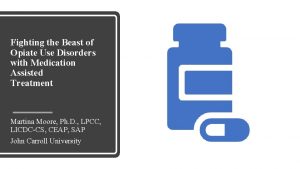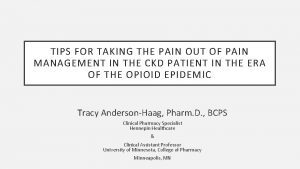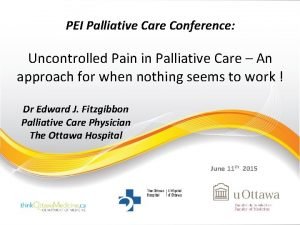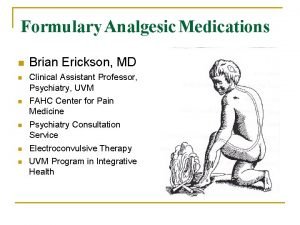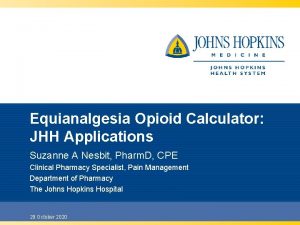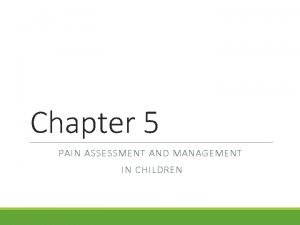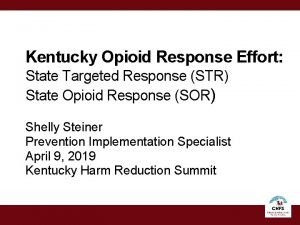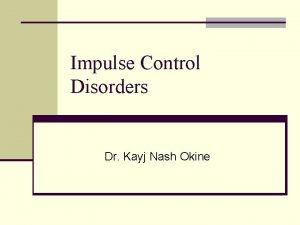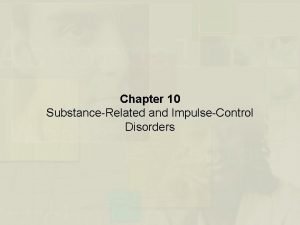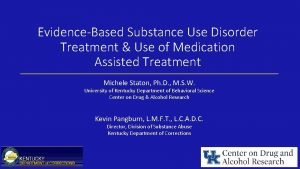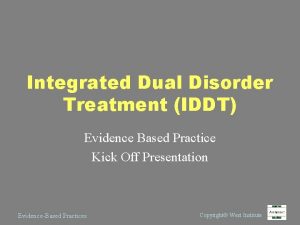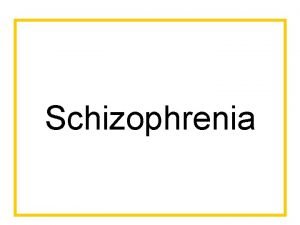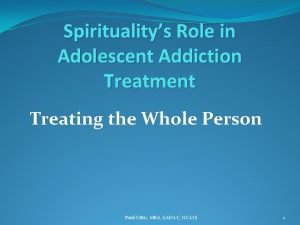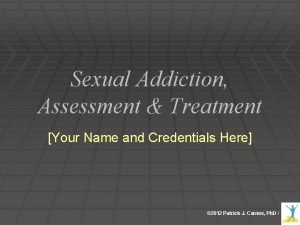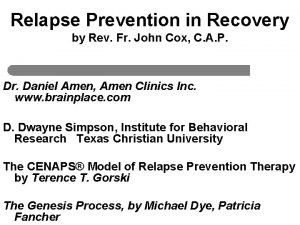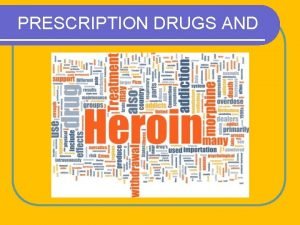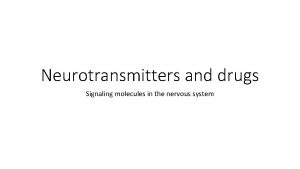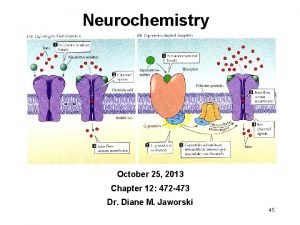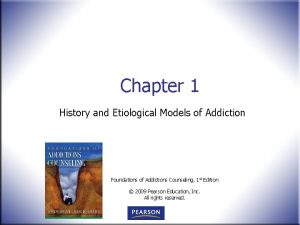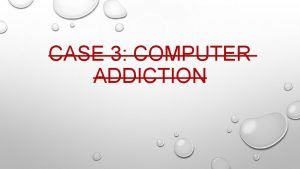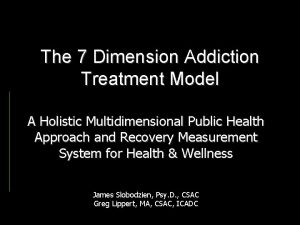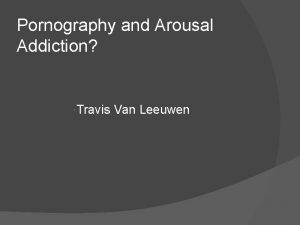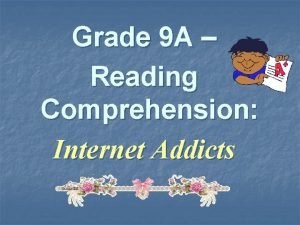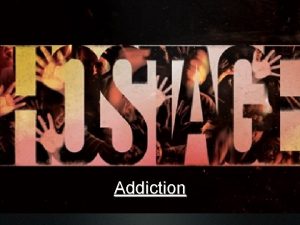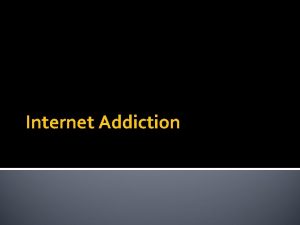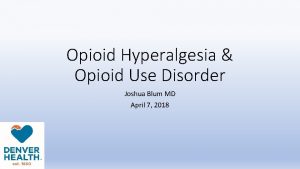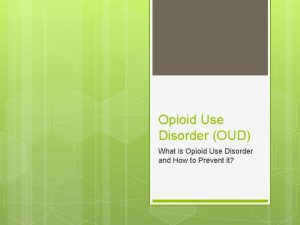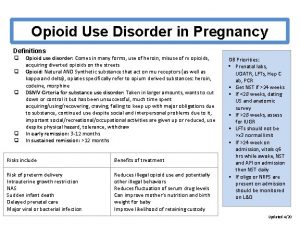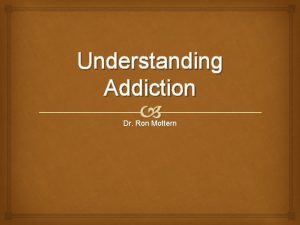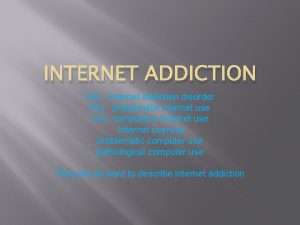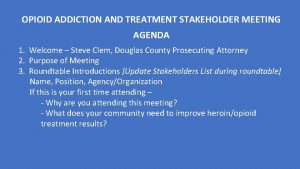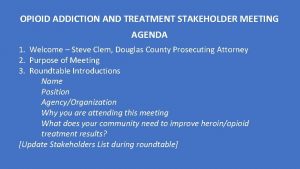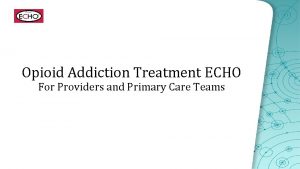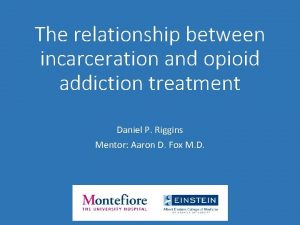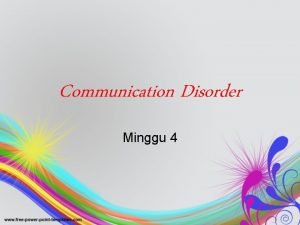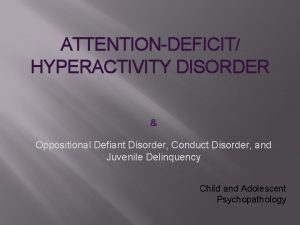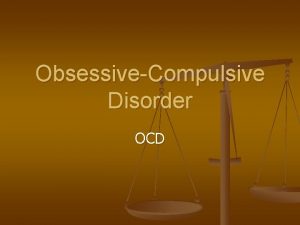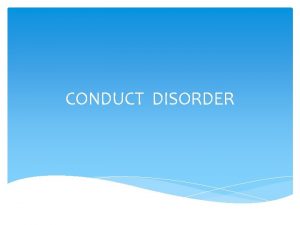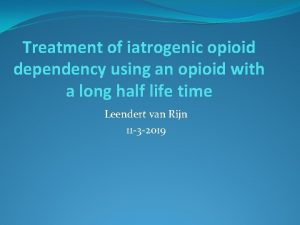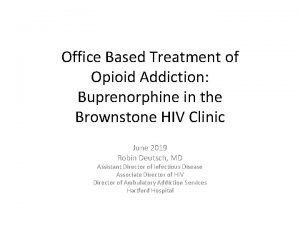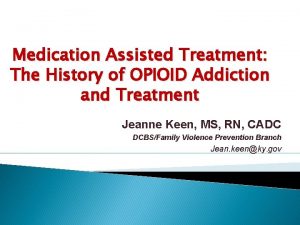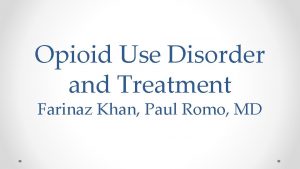Opioid Addiction Treatment Understanding the Disorder Treatment and












































































- Slides: 76

Opioid Addiction & Treatment: Understanding the Disorder, Treatment and Protocol A Training for Multidisciplinary Addiction Professionals

Disclosures The development of these training materials were supported by grant H 79 TI 080209 (PI: S. Becker) from the Center for Substance Abuse Treatment, Substance Abuse and Mental Health Services Administration, United States Department of Health and Human Services. The views and opinions contained within this document do not necessarily reflect those of the US Department of Health and Human Services, and should not be construed as such. These training materials were based upon materials created through the NIDA Blending Initiative and were updated by a New England ATTC trainer.

Disclosures The development of these training materials were supported by grant H 79 TI 080209 (PI: S. Becker) from the Center for Substance Abuse Treatment, Substance Abuse and Mental Health Services Administration, United States Department of Health and Human Services. The views and opinions contained within this document do not necessarily reflect those of the US Department of Health and Human Services, and should not be construed as such. These training materials were based upon materials created through the NIDA Blending Initiative and were updated by a New England ATTC trainer.

NIDA/SAMHSA Blending Initiative According to the Webster Dictionary definition To Blend means: a. combine into an integrated whole; b. produce a harmonious effect http: //www. merriam-webster. com/dictionary/blend

NIDA/SAMHSA Blending Initiative • Developed in 2001 by NIDA and SAMHSA/CSAT, the initiative was designed to meld science and practice to improve addiction treatment. • "Blending Teams, " include staff from CSAT's ATTCs and NIDA researchers who develop methods for dissemination of research results for adoption and implementation into practice. • Scientific findings are able to reach the frontline service providers treating people with substance use disorders. This is imperative to the success of drug abuse treatment programs throughout the country.

Blending Team Members Leslie Amass, Ph. D. – Friends Research Institute, Inc. Greg Brigham, Ph. D. – CTN Ohio Valley Node Glenda Clare, M. A. – Central East ATTC Gail Dixon, M. A. – Southern Coast ATTC Beth Finnerty, M. P. H. – Pacific Southwest ATTC Thomas Freese, Ph. D. – Pacific Southwest ATTC Eric Strain, M. D. – Johns Hopkins University ATTC representative NIDA researcher/Community treatment provider

Additional Contributors Judith Martin, M. D. – 14 th Street Clinic, Oakland, CA Michael Mc. Cann, M. A. – Matrix Institute on Addictions Jeanne Obert, MFT, MSM – Matrix Institute on Addictions Donald Wesson, M. D. – Independent Consultant The ATTC National Office

Goals for the Training • Participants will be able to state facts regarding: – the history of opioid treatment in the United States. – changes in the laws regarding treatment of opioid addiction and the implications for the treatment system. – how medication will benefit the delivery of opioid treatment. – the types of medications used to treat opioid use disorder • And to identify groups of people who are using opioids.

Introduction • Please introduce yourself: • Your name and the organization in which you work • Experience with opioid treatment JO HN • Your expectations for this training

An Introduction to SAMHSA/CSAT

SAMHSA/CSAT’s Mission: • To improve the lives of individuals and families affected by alcohol and drug abuse by ensuring access to clinically sound, costeffective addiction treatment that reduces the health and social costs to our communities and the nation. • CSAT's initiatives and programs are based on research findings and the general consensus of experts in the addiction field that, for most individuals, treatment and recovery work best in a community-based, coordinated system of comprehensive services. • Because no single treatment approach is effective for all persons, CSAT supports the nation's effort to provide multiple treatment modalities, evaluate treatment effectiveness, and use evaluation results to enhance treatment and recovery approaches.

The ATTC Network

The ATTC Network

An Introduction to NIDA

The Mission of the National Institute on Drug Abuse • To lead the Nation in bringing the power of science to bear on drug abuse and addiction • This charge has two critical components. – Strategic support and conduct of research across a broad range of disciplines – Ensuring the rapid and effective dissemination and use of the result of that research to significantly improve prevention, treatment and policy as it relates to drug use and addiction

What do you think? • What are your thoughts about the use of medication to treat opioid use disorders and other substance use disorders? • What thoughts do you have about treatment programs coming to your community?

Medication Assisted Treatment: The Myths and The Facts

MYTH #1: Patients are still addicted FACT: Addiction is pathologic use of a substance and may or may not include physical dependence. ü Physical dependence on a medication for treatment of a medical problem does not mean the person is engaging in pathologic use and other behaviors.

MYTH #2: Those medications are simply a substitute for heroin or other opioids FACT: The medications are corrective, not curative ü When taken as prescribed, they are safe. ü They allow the person to function normally, not get high. ü They are legally prescribed, not illegally obtained.

MYTH #3: Providing medication alone is sufficient treatment for opioid addiction FACT: Medication is an important treatment option. However, the complete treatment package must include other elements, as well. ü Combining pharmacotherapy with counseling and other ancillary services increases the likelihood of success.

MYTH #4: Patients are still getting high FACT: When taken as prescribed, the person will feel normal, not high. ü Buprenorphine has a ceiling effect resulting in lowered experience of the euphoria felt at higher doses. ü Naltrexone/Vivitrol has non-narcotic effects ü Methadone is highly medically monitored

A Brief History of Opioid Treatment

A Brief History of Opioid Treatment • 1964: Methadone is approved. • 1974: Narcotic Treatment Act limits methadone treatment to specifically licensed Opioid Treatment Programs (OTPs). • 1984: Naltrexone is approved, but has continued to be rarely used (approved in 1994 for alcohol addiction). • 1993: LAAM is approved (for non-pregnant patients only), but is underutilized.

A Brief History of Opioid Treatment • 2000: Drug Addiction Treatment Act of 2000 (DATA 2000) expands the clinical context of medicationassisted opioid treatment. – Expands the number of treatment slots – Allows opioid treatment in office settings (OBOT) – Establishes physician qualifications for prescribing • Establishes Physician Qualifications: – – Be licensed to practice by his/her state Have the capacity to refer patients for counseling Limit number of patients to 30 patients for the first year File for a new waiver after first year to increase to 100 patients.

A Brief History of Opioid Treatment – Be qualified to provide buprenorphine and receive a license waiver: • • Board certified in Addiction Psychiatry Certified in Addiction Medicine by ASAM or AOA Served as Investigator in buprenorphine clinical trials Completed 8 hours of training by ASAM, AAAP, AMA, AOA, APA (or other organizations that may be designated by Health and Human Services) • Training or experience as determined by state medical licensing board • Other criteria established through regulation by Health and Human Services

A Brief History of Opioid Treatment • October 8, 2002: Tablet formulations of buprenorphine (Subutex®) and buprenorphine/naloxone (Suboxone®) were approved by the FDA. – Product launched in U. S. in March 2003 – Interim rule changes to federal regulation (42 CFR Part 8) on May 22, 2003 enabled Opioid Treatment Programs to offer buprenorphine. 2004: Sale and distribution of ORLAAM® is discontinued. October, 2010: Vivitrol is approved for the treatment of opioid use disorder

A Brief History of Opioid Treatment • August 2016: CARA (Comprehensive Addiction and Recovery Act of 2016) – On July 6, 2016, the Department of Health and Human Services (HHS) released a final rule to increase access to medication-assisted treatment with buprenorphine products in the office setting by allowing eligible practitioners to request approval to treat up to 275 patients. – The final rule also includes requirements to ensure that patients treated by these practitioners receive high-quality care, and that aim to minimize the risk of diversion. – This will be effective on August 8, 2016.

A Brief History of Opioid Treatment To be eligible for a patient limit increase to 275, a physician must possess a current waiver to treat up to 100 patients, must have maintained that waiver without interruption for at least one year, and meet one of the following requirements: • Hold “additional credentialing, ” meaning board certification in addiction medicine or addiction psychiatry by the American Board of Addiction Medicine (ABAM) or the American Board of Medical Specialties (ABMS) or certification by the American Osteopathic Academy of Addiction Medicine, ABAM or ASAM; or

A Brief History of Opioid Treatment • Practice in a “qualified practice setting, ” meaning a practice that: – Provides professional coverage for patient medical emergencies during hours when the practitioner’s practice is closed; – Provides access to case-management services for patients including referral and follow-up services for programs that provide, or financially support, the provision of services such as medical, behavioral, social, housing, employment, educational, or other related services; – Uses health information technology (health IT) systems such as electronic health records, if otherwise required to use these systems in the practice setting. Health IT means the electronic systems that health care professionals and patients use to store, share, and analyze health information; – Is registered for their State prescription drug monitoring program (PDMP) where operational and in accordance with Federal and State law. – Accepts third-party payment for costs in providing health services, including written billing, credit, and collection policies and procedures, or Federal health benefits.

A Brief History of Opioid Treatment • Additionally, practitioners may not have had Medicare enrollment and billing privileges revoked under 42 CFR 424. 535 nor have been found to have violated the Controlled Substances Act pursuant to 21 U. S. C. 824(a) to be eligible for the higher limit. • It is expected that Nurse Practitioners and Physician Assistants will have prescribing privileges within 18 months of the enactment of this law. The specific requirements are currently unknown.

Prevalence of Opioid Use and Abuse in the United States

Rates of Current Heroin Use • The abuse of and addiction to opioids such as heroin, morphine and prescription pain relievers is a serious global problem. Rates of Past-Year Heroin Use – NSDUH, 2009 % of US population Individuals (12 & older) Adolescents (12 -17) Adults (18 -25) Adults (26 & older) 2003 2004 2005 2006 2007 2008 2011 2012 2013 0. 1 0. 2 0. 3 0. 1 0. 2 0. 1 0. 3 0. 4 0. 5 0. 7 0. 8 0. 7 0. 1 0. 2 0. 1 0. 3 0. 2 (SAMHSA, NSDUH: 2009 and 2014 ) and NIDA 2014

Prevalence of Opioid Use Of the 21. 5 million Americans 12 or older that had a substance use disorder in 2014, 1. 9 million had a substance use disorder involving prescription pain relievers and 586, 000 had a substance use disorder involving heroin.

2014 Statistics: Use and Deaths FIGURE 1. Age-adjusted rate* of drug overdose deaths† and drug overdose deaths involving opioids§, ¶ — United States, 2000– 2014

General Statistics • Drug overdose is the leading cause of accidental death in the US, with 47, 055 lethal drug overdoses in 2014. Opioid addiction is driving this epidemic, with 18, 893 overdose deaths related to prescription pain relievers, and 10, 574 overdose deaths related to heroin in 2014. • From 1999 to 2008, overdose death rates, sales and substance use disorder treatment admissions related to prescription pain relievers increased in parallel. The overdose death rate in 2008 was nearly four times the 1999 rate; sales of prescription pain relievers in 2010 were four times those in 1999; and the substance use disorder treatment admission rate in 2009 was six times the 1999 rate. • In 2012, 259 million prescriptions were written for opioids, which is more than enough to give every American adult their own bottle of pills.

General Statistics • Four in five new heroin users started out misusing prescription painkillers. As a consequence, the rate of heroin overdose deaths nearly quadrupled from 2000 to 2013. During this 14 -year period, the rate of heroin overdose showed an average increase of 6% per year from 2000 to 2010, followed by a larger average increase of 37% per year from 2010 to 2013. 94% of respondents in a 2014 survey of people in treatment for opioid addiction said they chose to use heroin because prescription opioids were “far more expensive and harder to obtain. ”

Impact on Special Populations • Adolescents (12 to 17 years old) In 2014, 467, 000 adolescents were current nonmedical users of pain reliever, with 168, 000 having an addiction to prescription pain relievers. In 2014, an estimated 28, 000 adolescents had used heroin in the past year, and an estimated 16, 000 were current heroin users. Additionally, an estimated 18, 000 adolescents had a heroin use disorder in 2014. People often share their unused pain relievers, unaware of the dangers of nonmedical opioid use. Most adolescents who misuse prescription pain relievers are given them for free by a friend or relative. The prescribing rates for prescription opioids among adolescents and young adults nearly doubled from 1994 to 2007.

Impact on Special Populations • Women are more likely to have chronic pain, be prescribed prescription pain relievers, be given higher doses, and use them for longer time periods than men. Women may become dependent on prescription pain relievers more quickly than men. • 48, 000 women died of prescription pain reliever overdoses between 1999 and 2010. Prescription pain reliever overdose deaths among women increased more than 400% from 1999 to 2010, compared to 237% among men. Heroin overdose deaths among women have tripled in the last few years. From 2010 through 2013, female heroin overdoses increased from 0. 4 to 1. 2 per 100, 000.

Who Uses Heroin? Individuals of all ages use heroin: • Today’s average first time heroin user is no longer a 16 year old male of color as it was in the ‘ 60’s, but more likely a 23 year old white woman. • White women among heroin users increased from 20% in the 50’s to approximately 52% in 2014. • White men and women have embraced prescription pills and turn to heroin when the source runs out. • 90% of people who started using heroin in the past decade are white, most of them in their late 20’s. • Heroin use increased significantly in suburbia. (JAMA Psychiatry, 2014)

Initiation of Heroin Use • During the latter half of the 1990 s, the annual number of heroin initiates rose to a level not reached since the late 1970 s. • In 1974, there were an estimated 246, 000 heroin initiates. • Between 1988 and 1994, the annual number of new users ranged from 28, 000 to 80, 000. • Between 1995 and 2001, the number of new heroin users was consistently greater than 100, 000. • Between 2002 and 2008, the number of new heroin users ranged from 91, 000 to 114, 000. (SAMHSA, OAS, 2008; SAMHSA, NSDUH, 2009)

New Non-Medical Users of Pain Relievers • In 2008 – 2. 2 million new non-medical users (a decline from 2. 5 million in 2003, but still a lot!) • 6, 000 new users per day • Among youth aged 12 -17, females more likely to use non-medically • Among young adults aged 18 -25, males more likely to use non-medically (SAMHSA, OAS, 2009)

Four Reasons for Not Entering Opioid Treatment 1. Limited treatment options – – – Methadone or Naltrexone Drug-Free Programming Limits placed on Suboxone prescribers 2. Stigma – Many users don’t want methadone – – Concerned about being stereotyped Not accepted by many abstinence-based programs and self-help groups. • • “It’s like going from the frying pan into the fire” Fearful of withdrawing from methadone 3. OTP’s are highly structured – – – Standing in line regardless of weather Standing in line and having access to pills, urine, etc. Going to the clinic every day until take-homes are earned

N. I. M. B. Y. Syndrome Methadone clinics are great, but Not In My Back Yard Ø New opioid treatment programs are difficult to open. Ø Zoning regulations and community reaction often create delays or prevent programs from opening. Ø Some states have few, one has none (ND)

A Need for Alternative Options • Move outside traditional structure to: – Attract more patients into treatment – Expand access to treatment – Reduce stigma associated with treatment • Buprenorphine and Vivitrol is a potential vehicle to bring about these changes.

Module I - Summary • Use of medications as a component of treatment can be an important in helping the person to achieve their treatment goals. • DATA 2000 expands the options to include both opioid treatment programs and the general medical system. • Opioid addiction affects a large number of people, yet many people do not seek treatment or treatment is not available when they do. • Expanding treatment options can – make treatment more attractive to people; – expand access; and – reduce stigma.

Continue only if presenting the 3 -hour training!

Review of Opioid Pharmacology, Medication. Assisted Treatment, and the Role of the Multidisciplinary Treatment Team

Opioid Addiction and the Brain • Opioids attach to specific receptors in the brain called mu receptors. • Activation of these receptors causes a pleasure response. • Repeated stimulation of these receptors creates a tolerance – requiring more drug for same effect.

Basic Opioid Facts Description: Opium-derived, or synthetics which relieve pain, produce morphine-like addiction, and relieve withdrawal from opioids Medical Uses: Pain relief, cough suppression, diarrhea Methods of Use: Intravenously injected, smoked, snorted, or orally administered

Basic Opioid Facts When Opiate Receptors are activated, they reduce the perception of pain and produce a sense of well-being. They can also cause drowsiness, mental confusion, nausea and constipation. With repeated illicit use, the production of endogenous opioids is inhibited and atrophies. With repeated use, tolerance sets in which results in need for more of the drug to achieve the desire effect. Some deaths due to lapse/relapse are related to tolerance; the user’s tolerance decreased during recovery.

Agonist Therapy: Methadone By the mid- and late 1960’s, heroin related mortality was the leading cause of death for young adults between ages 15 -35 in New York City. In 1962, Dr. Vincent Dole received grant to study feasibility of opiate maintenance in NY/Rockefeller University Dr. Nyswander and Dr. Mary Jeanne Kreek joined Dr. Dole’s staff in 1964

Agonist Therapy: Methadone • No euphoric/analgesic effects • Doses between 80 -120 mg held at level to block their euphoric and tranquilizing effects • No change in tolerance level over time • Could be taken once a day • Relieved craving attributed to relapse • Medically safe and nontoxic

Agonist Therapy: Methadone Proper dose lasts between 24 - 36 hours Does not create euphoria, sedation or analgesia Duration of treatment individualized Most significant long term effects on health is marked improvement • Side effects usually subside within a month • •

Agonist Therapy: Methadone “Loaded” “High” Normal Range “Comfort Zone” Subjective w/d “Sick” Objective w/d 0 hrs time 24 hrs

The Role of Buprenorphine in Opioid Treatment • Partial Opioid Agonist – Produces a ceiling effect at higher doses – Has effects of typical opioid agonists—these effects are dose dependent up to a limit – Binds strongly to opiate receptor and is long-acting • Safe and effective therapy for opioid maintenance and detoxification

Partial-Agonist Therapy: Buprenorphine • A synthetic opioid • Described as a mixed opioid agonist-antagonist (or partial agonist) • Available for use by certified physicians outside traditionally licensed opioid treatment programs

Partial-Agonist Therapy: Buprenorphine • Each tablet contains buprenorphine and naloxone in a 4: 1 ratio – Each 8 mg tablet contains 2 mg of naloxone – Each 2 mg tablet contains 0. 5 mg of naloxone • Ratio was deemed optimal in clinical studies – Preserves buprenorphine’s therapeutic effects when taken as intended sublingually – Sufficient dysphoric effects occur if injected by some physically dependent persons to discourage abuse

Buprenorphine Research Outcomes • Buprenorphine is as effective as moderate doses of methadone (Fischer et al. , 1999; Johnson, Jaffee, & Fudula, 1992; Ling et al. , 1996; Schottenfield et al. , 1997; Strain et al. , 1994). • Buprenorphine is as effective as moderate doses of LAAM (Johnson et al. , 2000). • Buprenorphine's partial agonist effects make it mildly reinforcing, encouraging medication compliance (Ling et al. , 1998). • After a year of buprenorphine plus counseling, 75% of patients retained in treatment compared to 0% in a placebo-plus-counseling condition (Kakko et al. , 2003).

Partial-Agonist Therapy: Buprenorphine • Treatment with buprenorphine-naloxone was associated with a reduction in opioid utilization and cost in the first year of follow-up (Kaur &Mc. Queen, 2008). • Systematic review found good studies supporting buprenorphine as a cost effective approach to opioid treatment (Doran, 2008).

Antagonist Medication: Vivitrol • Approved for use in treatment for opioid use disorder on October 12, 2010. • Approval followed a six-month clinical trial in which recovering adults were given either Vivitrol or a placebo. • 36% of those on Vivitrol were still in treatment at the end of the study compared to 23% on the placebo.

Antagonist Medication: Vivitrol • The recommended dose of VIVITROL is 380 mg delivered intramuscularly every 4 weeks or once a month. The injection should be administered by a health care professional as an intramuscular (IM) gluteal injection, alternating buttocks, using the carton components provided. VIVITROL must not be administered intravenously. • If a patient misses a dose, he/she should be instructed to receive the next dose as soon as possible. • Effectiveness in opioid treatment is related to: – Binding to opioid receptors in the brain, – Blocking neurotransmitters in the brain, – Eliminating pleasurable effects of recreational drugs such as alcohol, heroin and morphine.

Antagonist Medication: Vivitrol • Unlike methadone and buprenorphine, Vivitrol is administered via intramuscular injection. • Unlike methadone and buprenorphine which must be taken daily, Vivitrol is effective for 30 days. • It can be prescribed by a Prescribing Nurse, unlike buprenorphine.

Antagonist Medication: Vivitrol • Few to no side-effects occur when administered 710 days after the last use of an opioid. • Switching from Methadone or Buprenorphine to Vivitrol will require the 7 -10 day abstinence in order to have no opioids in the person’s system. • If opioids are present when the injection occurs, the person will be put into withdrawal.

Antagonist Medication: Vivitrol • There are no withdrawal symptoms when a person stops taking Naltrexone, or misses his/her next injection. • Some persons will take especially large amounts of opioids with the hope of being able to get high. This can lead to overdose and death. • Methadone is still the preferred and safer medication for pregnant women. • Naltrexone/Vivitrol will prohibit effectiveness of pain relieving narcotic medications.

Patient Selection • Counselors can screen and recommend patients for referral to qualified physicians. • Physicians will consider the following questions: • Is the patient currently addicted to opioids? • Is buprenorphine the best medication? • Is the office the best setting for treating the patient?

Patient Selection Assessment Questions • Is the patient addicted to opioids? • Is the patient aware of other available treatment options? • Does the patient understand the risks, benefits, and limitations of buprenorphine treatment? • Is the patient expected to be reasonably compliant? • Is the patient expected to follow safety procedures?

Patient Selection: Assessment Questions • Is the patient psychiatrically stable? • Is the patient taking other medications that may interact with buprenorphine? • Are the psychosocial circumstances of the patient stable and supportive? • Is the patient interested in office-based buprenorphine treatment? • Are there resources available in the office to provide appropriate treatment?

Issues Requiring Consultation with the Physician • Dependence upon high doses of benzodiazepines or other CNS depressants • Significant psychiatric co-morbidity • Multiple previous opioid treatment episodes with frequent relapse

Issues Requiring Consultation with the Physician • High level of dependence on high doses of opioids • High risk for relapse based on psychosocial or environmental conditions • Pregnancy • Poor support system

Issues Requiring Consultation with the Physician • HIV and STDs • Hepatitis or impaired liver function

Issues Requiring Consultation with the Physician • Use of alcohol • Use of sedative-hypnotics • Use of stimulants • Poly-drug addiction

General Counseling Issues • Confidentiality • Urine toxicology testing • Working with, not against, medication • Psychosocial treatment • Supporting medication maintenance • Patient comfort during withdrawal

Areas of Needs Assessment • • Drug use Alcohol use Social Issues Social Services Psychological history and status Education Vocational

Patient Management: Treatment Monitoring Goals for treatment should include: • • • No illicit opioid drug use No other drug use Absence of adverse medical effects Absence of adverse behavioral effects Responsible handling of medication Adherence to treatment plan

Patient Management: Treatment Monitoring Weekly visits (or more frequent) are important to: 1. Provide ongoing counseling to address barriers to treatment, such as travel distance, childcare, work obligations, etc 2. Provide ongoing counseling regarding recovery issues 3. Assess adherence to dosing regimen 4. Assess ability to safely store medication 5. Evaluate treatment progress

Patient Management: Treatment Monitoring • Urine toxicology tests should be administered at least monthly for all relevant illicit substances. • The medication can be tapered while psychosocial services continue. • The treatment team should work together to prevent involuntary termination of medication and psychosocial treatment. • In the event of involuntary termination, the physician and/or other team members should make appropriate referrals. • Physicians should manage appropriate withdrawal of medication to minimize withdrawal discomfort.
 Chess addiction treatment
Chess addiction treatment Avrt addiction treatment
Avrt addiction treatment Principles of drug addiction treatment
Principles of drug addiction treatment Malingering disorder
Malingering disorder Poss sedation scale
Poss sedation scale Metilmorfin
Metilmorfin Alprazolam äquivalenzdosis
Alprazolam äquivalenzdosis Opioid overdose
Opioid overdose Opioid overdose
Opioid overdose Opioid overdose
Opioid overdose Types of pain
Types of pain Mechanism of action of opioid analgesics
Mechanism of action of opioid analgesics Flacc pain scale
Flacc pain scale Opioid receptors location
Opioid receptors location Non-opioid
Non-opioid Suzanne nesbit
Suzanne nesbit Non-opioid
Non-opioid Kentucky opioid response effort
Kentucky opioid response effort Impulse control disorder treatment
Impulse control disorder treatment Impulse control disorder treatment
Impulse control disorder treatment Treatment of substance use disorder
Treatment of substance use disorder Integrated dual disorder treatment
Integrated dual disorder treatment Looseness of association
Looseness of association Spirituality and addiction
Spirituality and addiction Hát kết hợp bộ gõ cơ thể
Hát kết hợp bộ gõ cơ thể Lp html
Lp html Bổ thể
Bổ thể Tỉ lệ cơ thể trẻ em
Tỉ lệ cơ thể trẻ em Chó sói
Chó sói Glasgow thang điểm
Glasgow thang điểm Chúa yêu trần thế alleluia
Chúa yêu trần thế alleluia Môn thể thao bắt đầu bằng chữ f
Môn thể thao bắt đầu bằng chữ f Thế nào là hệ số cao nhất
Thế nào là hệ số cao nhất Các châu lục và đại dương trên thế giới
Các châu lục và đại dương trên thế giới Công thức tính độ biến thiên đông lượng
Công thức tính độ biến thiên đông lượng Trời xanh đây là của chúng ta thể thơ
Trời xanh đây là của chúng ta thể thơ Cách giải mật thư tọa độ
Cách giải mật thư tọa độ Làm thế nào để 102-1=99
Làm thế nào để 102-1=99 Phản ứng thế ankan
Phản ứng thế ankan Các châu lục và đại dương trên thế giới
Các châu lục và đại dương trên thế giới Thơ thất ngôn tứ tuyệt đường luật
Thơ thất ngôn tứ tuyệt đường luật Quá trình desamine hóa có thể tạo ra
Quá trình desamine hóa có thể tạo ra Một số thể thơ truyền thống
Một số thể thơ truyền thống Cái miệng xinh xinh thế chỉ nói điều hay thôi
Cái miệng xinh xinh thế chỉ nói điều hay thôi Vẽ hình chiếu vuông góc của vật thể sau
Vẽ hình chiếu vuông góc của vật thể sau Biện pháp chống mỏi cơ
Biện pháp chống mỏi cơ đặc điểm cơ thể của người tối cổ
đặc điểm cơ thể của người tối cổ Giọng cùng tên là
Giọng cùng tên là Vẽ hình chiếu đứng bằng cạnh của vật thể
Vẽ hình chiếu đứng bằng cạnh của vật thể Phối cảnh
Phối cảnh Thẻ vin
Thẻ vin đại từ thay thế
đại từ thay thế điện thế nghỉ
điện thế nghỉ Tư thế ngồi viết
Tư thế ngồi viết Diễn thế sinh thái là
Diễn thế sinh thái là Dot
Dot Bảng số nguyên tố
Bảng số nguyên tố Tư thế ngồi viết
Tư thế ngồi viết Lời thề hippocrates
Lời thề hippocrates Thiếu nhi thế giới liên hoan
Thiếu nhi thế giới liên hoan ưu thế lai là gì
ưu thế lai là gì Khi nào hổ mẹ dạy hổ con săn mồi
Khi nào hổ mẹ dạy hổ con săn mồi Sự nuôi và dạy con của hươu
Sự nuôi và dạy con của hươu Hệ hô hấp
Hệ hô hấp Từ ngữ thể hiện lòng nhân hậu
Từ ngữ thể hiện lòng nhân hậu Thế nào là mạng điện lắp đặt kiểu nổi
Thế nào là mạng điện lắp đặt kiểu nổi Recovery zone sex addiction test
Recovery zone sex addiction test Faster scale addiction
Faster scale addiction Learn.genetics.utah/content/addiction/mouse
Learn.genetics.utah/content/addiction/mouse Http://learn.genetics.utah.edu/content/addiction/
Http://learn.genetics.utah.edu/content/addiction/ Http://learn.genetics.utah.edu/content/addiction/
Http://learn.genetics.utah.edu/content/addiction/ Etiological models of addiction
Etiological models of addiction Give two pieces
Give two pieces Addiction expert witnesses
Addiction expert witnesses 7 dimensions of addiction
7 dimensions of addiction Arousal addiction
Arousal addiction Internet addiction reading comprehension
Internet addiction reading comprehension
